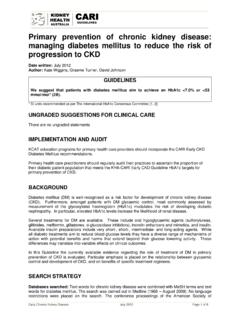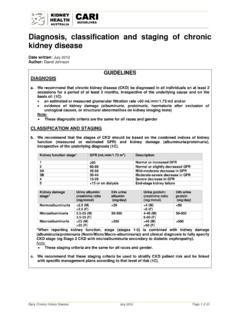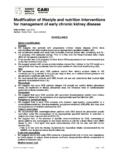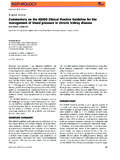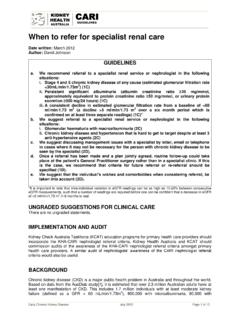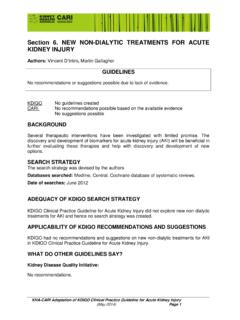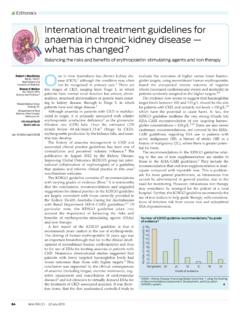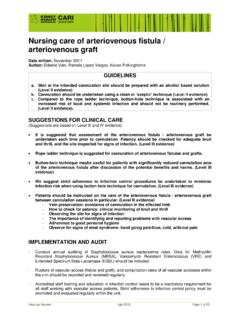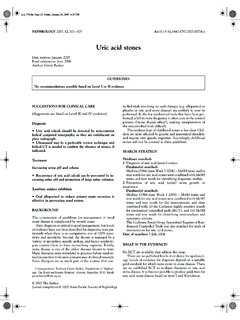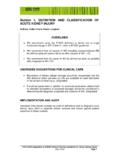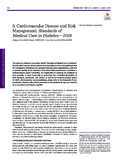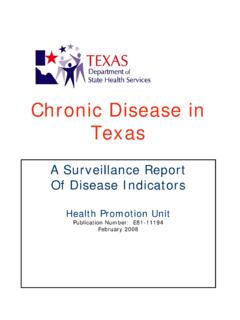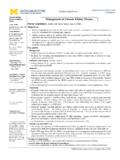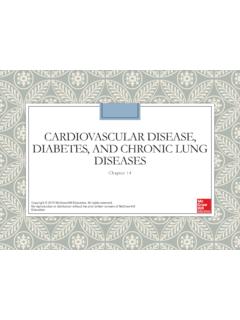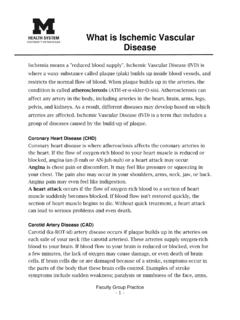Transcription of Cardiovascular disease in patients with chronic kidney disease
1 KHA-CARI GuidelineCardiovascular disease in patients with chronic kidney diseaseHELEN PILMORE,1 GURSHARAN DOGRA,2 MATTHEW ROBERTS,3,4 HIDDO J LAMBERS HEERSPINK,6 TOSHIHARU NINOMIYA,7 RACHEL HUXLEY5and VLADO PERKOVIC51 Department of Renal Medicine, Auckland City Hospital and Department of Medicine, Auckland University, Auckland, New Zealand;2 Department of RenalMedicine, Sir Charles Gairdner Hospital, Perth, Western Australia,3 Department of Nephrology, Austin Health,4 Department of Medicine, University ofMelbourne, Melbourne,5 The George Institute for Global Health, The University of Sydney, Sydney, New South Wales, Australia;6 Department of ClinicalPharmacology, University Medical Center Groningen, University of Groningen, Groningen, The Netherlands.
2 And7 Department of Nephrology, Hypertension, andStrokology, Kyushu University Hospital, Kyushu, JapanCorrespondence:Dr Helen Pilmore, Department of Renal Medicine,Auckland City Hospital and Department of Medicine,Auckland University, Auckland, New : for publication 1 August manuscript online 8 August REVASCULARIZATIONG uideline recommend that in patients with chronic kidneydisease (CKD), end-stage renal failure (ESRF) and afterkidney transplantation, that guidelines for revascularizationof the general population be adhered to (1D).
3 Ungraded suggestions for clinical care patients with evidence of coronary artery disease shouldbe referred to a cardiologist for expert opinion (ungraded). Physicians should be aware that revascularization ofcoronary arteries with coronary artery bypass graft (CABG)and percutaneous intervention (PCI) is associated withgreater mortality and morbidity in patients with CKD andthose on dialysis compared with the general population(ungraded).BackgroundCardiovas cular disease is the leading cause of death inpatients with ESRF.
4 The risk of Cardiovascular death is sig-nificantly reduced in the renal transplant population com-pared with those on dialysis, but is still significantly greaterthan that of the general addition, the risk ofcardiac death and major cardiac events is greater in thosewith CKD than those with normal renal ,3 Revascularization of coronary artery stenoses has beenextensively studied in the general population and guidelinesfor the management of both unstable4and stable5coronaryartery disease (CAD) have been generated using evidencefrom randomized controlled trials (RCTs).
5 However, in mosttrials, patients with significant renal impairment have aim of this guideline is to review the literature andassess the benefits and harms of revascularization of CAD inpatients with CKD, including the dialysis and transplantpopulations. The revascularization literature was examinedboth in unstable and stable data regarding revascularization of patients withkidney disease are sparse, especially in regards to RCTs. Incontrast there is a large body of data and hence many guide-lines in the general population.
6 In the absence of any con-trary data, we recommend that guidelines for patients in thegeneral population be followed. Both the current ACCF/AHA and European guidelines include special mention ofpatients with of the evidenceThereislimitedevidencefromRCTsco mparingrevascularization with medical therapy specific for patientswith CKD. The available data including ad hoc sub groupanalyses of RCTs conducted in the general population does notcurrently justify guideline recommendations specific topeople with CKD for either stable or unstable comparison with the general population, patients withCKD are at increased risk of early and late mortality afterCABG.
7 patients on dialysis have a greater perioperative mor-tality than those with normal renal function after CABG andmarkedly reduced long-term survival compared with thegeneral (2014) 3 10 2013 Asian Pacific Society of Nephrology3 CKD patients and patients on dialysis treated with PCIusing angioplasty are at greater risk of long-term mortalityand major cardiac events compared with those with normalrenal are few outcome studies following CABG or PCI thathave included transplant recipients and none of these haveincluded control groups for are no RCTs comparing outcomes associated withbare metal stents (BMS)versusdrug eluting stents (DES) ordifferent types of DES.
8 Retrospective data for both CKD anddialysis patients is inconclusive in relation to the use of DEScompared to BMS and associations with mortality, majorcardiac events and restenosis. There are currently insufficientdata to support guideline recommendations on the use ofDES specific to patients with CKD or those on dialysis. Simi-larly there has been limited assessment of outcomes follow-ing the use of stents in transplant McDonald S, Excell L, Livingston 2008 Annual Australia: Austalia and New Zealand Dialysis and TransplantRegistry, Anavekar NS, McMurray JJV, Velazquez EJet al.
9 Relation betweenrenal dysfunction and Cardiovascular outcomes after Engl. J. ;351: 1285 Go AS, Chertow GM, Fan Det al. chronic kidney disease and therisks of death, Cardiovascular events, and Engl. ;351: 1296 Fihn SD, Gardin JM, Abrams Jet al. 2012 ACCF/AHA/ACP/AATS/PCNA/SCAI/STS Guideline for the Diagnosisand Management of patients with Stable Ischemic Heart disease : AReport of the American College of Cardiology Foundation/AmericanHeart Association Task Force on Practice Guidelines, and theAmerican College of Physicians, American Association for ThoracicSurgery, Preventive Cardiovascular Nurses Association, Society forCardiovascular Angiography and Interventions, and Society ofThoracic ;126: e354 Jneid H, Anderson JL, Wright RSet al.
10 2012 ACCF/AHA FocusedUpdate of the Guideline for the Management of patients WithUnstable Angina/Non-ST-Elevation Myocardial Infarction (Updatingthe 2007 Guideline and Replacing the 2011 Focused Update): AReport of the American College of Cardiology Foundation/AmericanHeart Association Task Force on Practice ;126: 875 MEDICAL MANAGEMENTG uideline recommendationsAcute coronary recommend that all CKD patients , including haemo-dialysis, peritoneal dialysis and transplant patients , should betreated as per the general population when presenting with anacute coronary syndrome (ACS) ST-elevation myocardialinfarction (STEMI) or non-ST-elevation acute coronary syn-drome (NSTE-ACS) with regards to reperfusion therapy,antiplatelet therapy (aspirin and clopidogrel)
